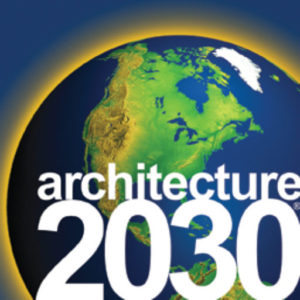Targeting 100! Envisions a High Performance Hospital Meeting 2030 Challenge Targets
/in 2030 Challenge/by arch2030What is Architecture 2030?
/in 2030 Challenge, Announcements/by arch2030
Architecture 2030 is a non-partisan, solution oriented research organization founded in response to the energy and climate change crisis in 2003 and formally established as a non-profit in 2006.”
Architecture 2030’s goal is to achieve dramatic and measurable reductions in the fossil fuel consumption and greenhouse gas (GHG) emissions of the Building Sector by transforming the way buildings and developments are planned, designed, constructed and operated.
Architecture 2030 (sometimes referred to simply as ‘2030’) revealed the true impact of buildings on climate change. Performing extensive research, 2030 discovered that the Building Sector is both the largest energy consumer (49%) and the largest contributor to GHG emissions (46%) in the U.S.
Architecture 2030 (sometimes referred to simply as ‘2030’) revealed the true impact of buildings on climate change. Performing extensive research, 2030 discovered that the Building Sector is both the largest energy consumer (49%) and the largest contributor to GHG emissions (46%) in the U.S.
This information, together with the timeline for CO2reductions mandated by the scientific community and the organization’s extensive knowledge and experience with buildings, led the organization to officially issue the ‘2030 Challenge’ in January of 2006. A global initiative, the 2030 Challenge calls for all new buildings and major renovations to reduce their fossil-fuel, GHG-emitting consumption by 60% today, 70% in 2015, 80% in 2020, 90% in 2025 and to reach carbon-neutrality (using no fossil-fuel, GHG-emitting energy to operate) by the year 2030.
From 2006 onward, 2030 has worked to educate and collaborate with key stakeholders to implement the 2030 Challenge at the local, state, and federal levels, as well as internationally. Through its website, research, publications, reports, keynotes and lectures, programs, events, diverse media outlets, and social networks, 2030 seeks to broaden adoption and implementation of the 2030 Challenge.
Now that you’ve gotten the long answer, why not visit our brand new website www.architecture2030.org if you’ve still got questions.
2010 Imperative Global Emergency Teach-In
/in 2030 Challenge, Videos/by arch2030A quarter million people from 47 different countries gathered here on February 20, 2007 to participate in The 2010 Imperative: A Global Emergency Teach-in conducted by Architecture 2030. During this interactive webcast, 2030 issued the 2030 Challenge and the 2010 Imperative, specific achievable strategies to transform the built environment. These strategies are designed to immediately stabilize energy consumption and GHG emissions in the Building Sector, and then reverse them to acceptable levels over the next twenty years.
Architecture 2030 thanks all those who participated in the webcast!
Program Schedule
WELCOMING REMARKS
Susan Szenasy, Editor, Metropolis magazine
Susan Szenasy is editor-in-chief of Metropolis, and has led the award-winning New York City-based magazine of architecture, culture and design through twenty years of landmark design journalism.
In a recent university lecture, Szenasy summed up her role at Metropolis, “As an editor, my job is to ask questions. So the question I ask of you now is this: how will you prepare yourself to make hard choices? And as a follow-up, what can you contribute to making a new pattern, one that reflects the 21st century ethos of environmental sustainability and social equity? Are you willing to take part in redefining the edge?”
A THREAT TO THE PLANET
Dr. James Hansen, Director, NASA Goddard Institute for Space Studies
Dr. James Hansen is arguably the world’s leading scientist on global warming. He is the head of NASA’s Goddard Institute for Space Studies in New York City.
Ralph Cicerone, president of the National Academy of Sciences said of Dr. Hansen’s climate science work, “I can’t think of anybody who I would say is better than Hansen. You might argue that there’s two or three others as good, but nobody better.”
RESUSCITATING A DYING WORLD
Edward Mazria, AIA, Founder, Architecture 2030
Edward Mazria, founder of Architecture 2030, is an internationally recognized architect, author and educator. His architecture and planning projects span a thirty-year period, each employing a cutting-edge environmental approach to its design.
After the AIA, USGBC and ASHRAE recently adopted the 2030 Challenge to address the Building Sector’s role in the global warming crisis, Mazria wrote “The task we face is daunting. Working separately, we could accomplish something significant in each of our respective spheres. But by working together, we actually have a chance to influence the course of history.”
DOING IS BELIEVING
Chris Luebkeman, Director, Global Foresight and Innovation Initiative, ARUP
Chris Luebkeman is a Director and leader of Arup’s global Foresight and Innovation initiative. He is tasked with exploring and synthesizing the trends affecting society’s development.
Luebkeman is a senior fellow of the Design Futures Council and in a recent article wrote, “There is no doubt that, as our built environment has transformed from a local phenomenon to a global one, we are now confronted with more pressing social, technological, economic, environmental and political change forcing us to a local mindset – on a global scale.”
DISCUSSION AND Q&A
Part 1
Part 2
Part 3
Sponsored by:
The American Institute of Architects, The Home Depot Foundation, U.S. Green Building Council, Rockefeller Brothers Fund, New York Academy of Sciences, AIA Large Firm Roundtable.
Supported by:
AIA NYC, AIA COTE, Skidmore, Owings & Merrill LLP, Metropolis Magazine, AIAS, SBSE, ACSA, UIA, RAIC, ASES, Jonathan Rose Companies LLC, Turner Construction, National Wildlife Federation, BuildingGreen, Inc., D+Arquitectos
ABOUT US
Architecture 2030’s mission is to rapidly transform the built environment from the major contributor of greenhouse gas emissions to a central solution to the climate crisis.

